Activists Explore Joyful Transformation
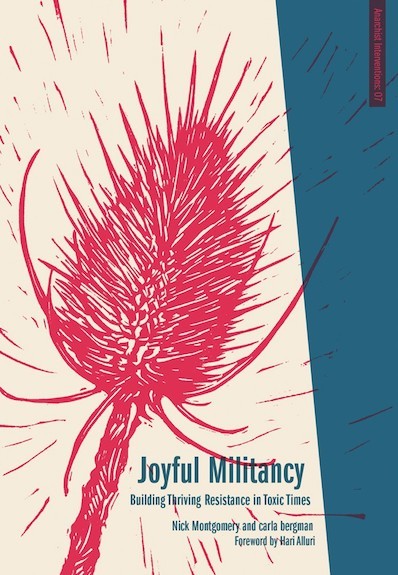
Cover of Joyful Militancy: Building Thriving Resistance in Toxic Times Credit: AK Press, see link below
The authors of a book about joy in social-justice activism discuss how activists can be less “rigid” and discover a broad sense of rejuvenating kinship.
carla bergman is a mom, filmmaker, writer, and organizer who spends much of her time with her partner, kids and friends in east Vancouver, Coast Salish Territories. She is the co-director of EMMA Talks, a mini-art-festival and speaker’s series by women.
She also co-directed the film, Common Notions: Handbook Not Required , co-edited the book, Stay Solid: A Radical Handbook For Youth , and, with Nick Montgomery, co-authored the book Joyful Militancy: Building Thriving Resistance in Toxic Times .
Nick Montgomery is an organizer and theory nerd living in Victoria on Lekwungen territory.
James Wilt interviewed the pair for the Winter 2017 issue of Geez Magazine.
How does Empire exploit fear as a power to divide us or keep us from acting?
Dominant culture and institutions in North America are based in hundreds of years of domination and terror – the dominant order is very much based on fear. But we think it’s also important to emphasize that even the most terroristic violence has always been (and continues to be) resisted: slaves broke their tools and poisoned their masters; women led peasant rebellions in Europe; Indigenous women kept their ways of being and languages alive; sailors deserted or mutinied and formed pirate communities.
In Joyful Militancy we specifically emphasized schooling as a major force that implants fear in most of us early in life. Schooling pits us against each other from an early age – it subjects us to constant measuring and monitoring, and teaches us to fear mistakes. To succeed is to be better than others, and making mistakes means losing. This is really insidious because failure and mistakes are key to experimenting and working together – everyone fails sometimes, but this fear of messing up shows up in organizing and activist spaces. And so does competitiveness: there’s a pervasive tendency to evaluate ourselves and others.
Fear is also connected to isolation. Neoliberal capitalism encourages us to think of ourselves as isolated little units with our own profiles and jobs and bank accounts, all pitted in petty competitions with each other. Connected to this, capitalism nurtures a sense of scarcity – that there just isn’t enough to go around. There’s definitely nothing wrong with being afraid, but these forms of fear have been weaponized to make us anxious and compliant. They’re insidious because they’re linked to a sense of powerlessness – they make us feel that we’re incapable of changing our situations or participating in collective transformation.
 All this becomes really clear in situations of disaster (earthquakes, hurricanes, and so on) when some of the infrastructures of capitalism and the state are suspended, at least temporarily. In these situations, there is a lot to be afraid of: there are real urgent needs for clean water, food, warmth, medical care, and so on. The consistent response of governments is militarized policing coupled with tiered bureaucratic disaster relief, which often neglects and criminalizes the most marginalized – poor people, Indigenous folks, people of colour, and so on. There are also vigilantes and reactionary violence in these situations; it’s a disaster on many fronts. But people don’t just wait around in fear; there’s a consistent response from everyday people to organize themselves, take care of each other (including strangers), and figure things out together.
All this becomes really clear in situations of disaster (earthquakes, hurricanes, and so on) when some of the infrastructures of capitalism and the state are suspended, at least temporarily. In these situations, there is a lot to be afraid of: there are real urgent needs for clean water, food, warmth, medical care, and so on. The consistent response of governments is militarized policing coupled with tiered bureaucratic disaster relief, which often neglects and criminalizes the most marginalized – poor people, Indigenous folks, people of colour, and so on. There are also vigilantes and reactionary violence in these situations; it’s a disaster on many fronts. But people don’t just wait around in fear; there’s a consistent response from everyday people to organize themselves, take care of each other (including strangers), and figure things out together.
It happened again as hurricanes hit the U.S., the Caribbean, and Mexico: there were grassroots relief efforts that provided food, water, and other supplies, and also set up infrastructure like free medical clinics and community spaces. Rebecca Solnit writes about this in Paradise Built in Hell, The Extraordinary Communities That Arise in Disaster]; people often take incredible risks and do really generous things for people they don’t know well in these situations, and they often feel more alive and connected.
That doesn’t mean we should wish for disasters. The point for us is that capitalist infrastructures and routines close off possibilities for connection and experimentation. The real disasters are capitalism and the state. Everyday life includes real scarcity but also forms of mutual aid, solidarity, and cooperation. This might look like counter-institutions and intentional projects like social centres, or it might be more fluid forms of direct action and collaboration. In any case, changing our relationships here and now is one way to combat this kind of fear. It’s challenging, and it requires a fierce commitment to each other, but it’s ultimately about carving out forms of collective struggle, love, and care.
What does “rigid radicalism” and a “norm of fearlessness” look like in activist circles? Are there ways that you think groups can try to work against that norm?
We tried to talk about rigid radicalism as a kind of proliferation of ‘right ways to be’ that take shape in different radical spaces, with different relationships to fear. In researching and writing the book, we interviewed folks from a bunch of different spaces and movements, and we try to avoid homogenizing what’s going on, but it seems that these kinds of conversations are pretty widespread – a lot of people are talking about how radical/activist spaces in North America can feel scary, cold, rigid, and so on. So we’re not trying to pinpoint one norm or space; it’s really complex.
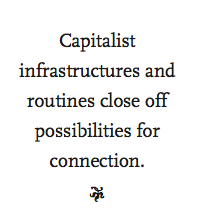 In some spaces, this might look like a norm of fearlessness where we are all expected to want to fight with cops on the street – a kind of macho fearlessness that is sometimes called “manarchism.”
In some spaces, this might look like a norm of fearlessness where we are all expected to want to fight with cops on the street – a kind of macho fearlessness that is sometimes called “manarchism.”
But the norm might look totally different than that. It might take the shape of needing to use the right words, and calling people out for bad words or behaviours – a kind of searching for flaws that comes with the flip-side of being scared to fuck up.
Or it might look like being super critical and cynical, so that you’re never too invested, never get carried away, and never surprised by any- thing – a kind of intellectual paranoia that is scared to be naïve, above all.
To be clear, there’s nothing wrong with fighting cops, or calling people out, or being critical – the problem is when they become norms that eat away at our capacity to experiment and connect. The norms of rigid radicalism might be totally different, and they even come into conflict sometimes, but they all close down possibilities for curiosity, working across difference, and transformation. Our main argument is that all these norms get in the way of our capacity to be different with each other and to create solid bonds.
The challenge is to find ways to work together based in shared commitments and values without imposing that on everyone else. So we are trying to refuse the idea that there’s a right answer for everyone, but that doesn’t mean it’s all relative and “anything goes.” Refusing rigid radicalism doesn’t mean being totally open or flexible. It means that boundaries and firm lines are absolutely crucial, but they can’t be dictated by some prefabricated moral or ideological framework – it’s about figuring out how to do it together, in a way that’s emergent and depends on input from everyone involved, including kids.
Can fear itself be harnessed in a positive way? What could that actually look like?
Definitely. Resistance is often animated by emotions that are classified as “negative” – fear, rage, and despair are all emotions that we’re often told to avoid, but these are the feelings that often spark rebellion and revolt. From the Arab Spring to Ferguson to movements like ACT UP and Black Lives Matter, fear and rage and despair are undeniably linked to resistance. In the book we tried to insist that no emotions are “bad” – and in fact all kinds of problems are created when we try to get rid of certain kinds of emotions. This can lead to an expectation that we should be happy all the time, or trying to police away peoples’ anger (often along gendered and racialized lines). Rather than trying to avoid fear, we’d emphasize the importance of trying to inhabit situations more fully and embrace more of our messy selves.
 When we interviewed adrienne maree brown , for instance, she talked about striving to embrace her trauma, triggers, and brilliance. Maybe fear can be embraced in this way too. Sharing fears and hopes – and letting them breathe a little – can create intimate connections and open space to think and feel differently. That doesn’t mean sharing fears is always desirable; the point is to navigate fear in transformative ways, starting right where we are, and that will always look different.
When we interviewed adrienne maree brown , for instance, she talked about striving to embrace her trauma, triggers, and brilliance. Maybe fear can be embraced in this way too. Sharing fears and hopes – and letting them breathe a little – can create intimate connections and open space to think and feel differently. That doesn’t mean sharing fears is always desirable; the point is to navigate fear in transformative ways, starting right where we are, and that will always look different.
Another way to approach fear is by connecting to legacies of resistance and rebellion. If fear is most toxic when it makes us feel isolated and alone, then looking back at histories of struggle can help us see ourselves as part of longstanding currents of resistance and change. And this can also help us recognize points of tension and forms of resistance here and now: the places in our neighbourhoods where resistance has been papered over by Empire and might be reactivated again.
Can you share some approaches to embracing the kinds of transformation you’re talking about in the book?
In the book we’re interested in what might foster what we call joyful transformation. We focus on the concept of joy because it’s about immediate transformation. For the lineage of theory we’re drawing on, joy isn’t the same as optimism or happiness and it doesn’t promise a better future – it’s the name for a process of transformation that makes us more capable and alive right now. It might feel really scary, because we can’t know in advance where that process will take us.
One of our basic premises is that transformative potentials are always already present and emergent. So we talk a bit about the mass uprisings in places like Argentina, Mexico, and Greece, but we try to connect those big upwellings to smaller forms of resistance and transformation. The power of those moments is their capacity to interrupt the 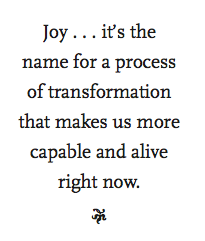 shitty forms of life imposed by Empire, and open space for something different – even if dominant institutions eventually re-establish control.
shitty forms of life imposed by Empire, and open space for something different – even if dominant institutions eventually re-establish control.
And then the challenge is to recognize that this is going on in smaller ways all the time: people constantly are figuring out how to relate differently, how to refuse some of what’s being imposed on them. At any scale, experimentation and curiosity is crucial. Joyful transformation is open-ended, which means it can’t be about following a blueprint or deciding what to do in advance. Along these lines, the Zapatistas talk about “walking with questions.”
A related theme is the importance of strong and intimate ties. We were really inspired by Donna Haraway’s recent work where she insists that “making kin” is the most important thing we can do today. White supremacy and heteropatriarchy has tried to contain kinship within the nuclear family, and it has attacked those who make kin differently, so we wanted to hold up all the ways that people are building strong bonds across divides of race, gender, ability, species, and so on. That might look like deep friendship, or chosen family, or an intimate connection with place and more-than-human beings. All that is connected to our next collaborative project that will be a podcast called “Making Kin at the Edges.” We want to create space for dialogue about themes like fear, families, grief, and so on – all the ways that people are building intimate connections against the grain of Empire.
Nick Montgomery and carla bergman’s book, Joyful Militancy: Building Thriving Resistance in Toxic Times was published this year by AK Press (see joyfulmilitancy.com). You can read more from Nick at cultivatingalternatives.com, and carla at joyfulthreadsproductions.com. Their new project, Making Kin at the Edges, has a social media page at facebook.com/ KinattheEdges.
James Wilt is a freelance journalist and the Civil Disobedience Editor for Geez Magazine.
Image: AK Press
Dear reader, we welcome your response to this article or anything else you read in Geez magazine. Write to the Editor, Geez Magazine, 400 Edmonton Street, Winnipeg, Manitoba, R3B 2M2. Alternately, you can connect with us via social media through Twitter, Facebook, or Instagram.

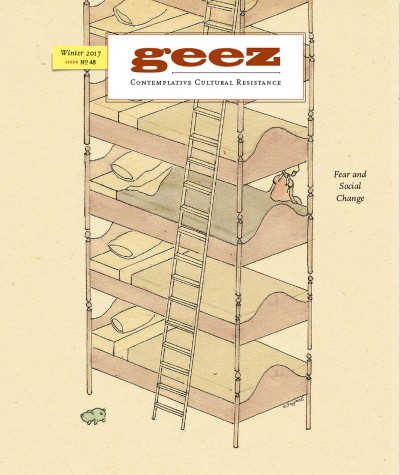
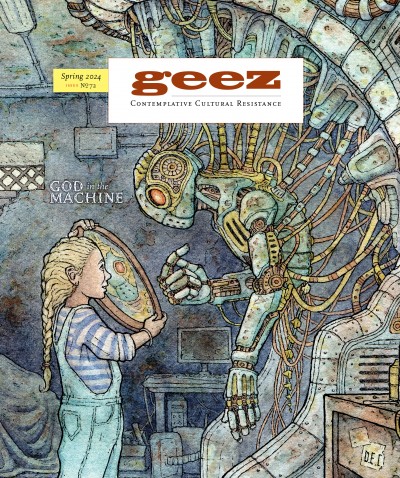
Sorry, comments are closed.